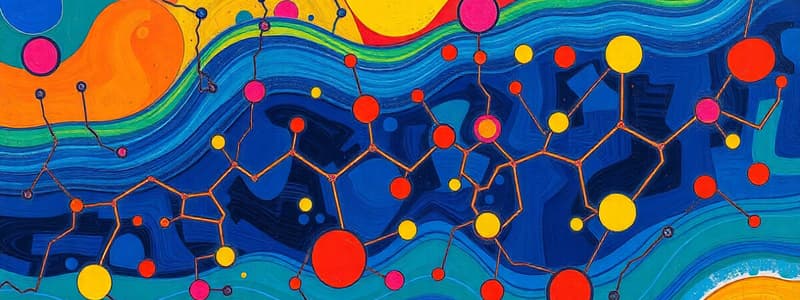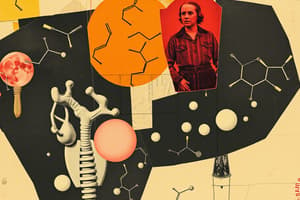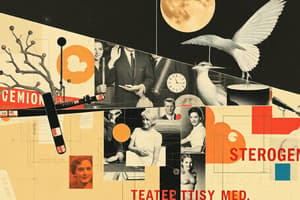Podcast
Questions and Answers
Which hormone is primarily responsible for stimulating ovulation?
Which hormone is primarily responsible for stimulating ovulation?
- LH (correct)
- FSH
- Estrogen
- Progesterone
What role does relaxin play during pregnancy?
What role does relaxin play during pregnancy?
- Promotes uterine contractions
- Stimulates egg production
- Prepares the cervix for labor
- Inhibits uterine contractions (correct)
How does testosterone primarily circulate in the blood?
How does testosterone primarily circulate in the blood?
- Only bound to albumin
- As free testosterone only
- Exclusively in inactive forms
- Bound tightly to SHBG, weakly to albumin, and as free testosterone (correct)
Which structure is responsible for the fertilization of the egg?
Which structure is responsible for the fertilization of the egg?
What is the primary function of estrogen produced by secondary follicles?
What is the primary function of estrogen produced by secondary follicles?
What happens to the uterine membrane without implantation?
What happens to the uterine membrane without implantation?
What can untreated STDs potentially lead to?
What can untreated STDs potentially lead to?
Which part of the female reproductive system is directly involved in the growth of a fetus?
Which part of the female reproductive system is directly involved in the growth of a fetus?
What is the first and rate-determining step in steroidogenesis?
What is the first and rate-determining step in steroidogenesis?
Which of the following is a primary source of cholesterol for steroidogenesis in humans?
Which of the following is a primary source of cholesterol for steroidogenesis in humans?
What are the two organelles where steroidogenesis occurs?
What are the two organelles where steroidogenesis occurs?
Which receptor is primarily involved in cholesterol uptake for steroidogenesis in rodents?
Which receptor is primarily involved in cholesterol uptake for steroidogenesis in rodents?
What role does Niemann Pick type C1 (NPC1) play in steroidogenesis?
What role does Niemann Pick type C1 (NPC1) play in steroidogenesis?
Which process requires cholesterol as a raw material?
Which process requires cholesterol as a raw material?
How do the cytoskeleton and microtubule tracks contribute to steroidogenesis?
How do the cytoskeleton and microtubule tracks contribute to steroidogenesis?
Which class of steroid hormones includes androgens, estrogens, and progesterone?
Which class of steroid hormones includes androgens, estrogens, and progesterone?
What type of enzymes are involved in the process of steroidogenesis?
What type of enzymes are involved in the process of steroidogenesis?
Which of the following best describes the activity of hydroxysteroid dehydrogenases (HSDs)?
Which of the following best describes the activity of hydroxysteroid dehydrogenases (HSDs)?
How many CYP450 enzymes are specifically involved in steroidogenesis out of the total present in the human genome?
How many CYP450 enzymes are specifically involved in steroidogenesis out of the total present in the human genome?
What is the primary role of reproductive hormones?
What is the primary role of reproductive hormones?
What activates molecular oxygen in CYP450 enzymes?
What activates molecular oxygen in CYP450 enzymes?
Which statements about the hormonal axis are correct?
Which statements about the hormonal axis are correct?
What type of co-factors do HSDs require for their reactions?
What type of co-factors do HSDs require for their reactions?
Which statement accurately describes CYP450 enzymes?
Which statement accurately describes CYP450 enzymes?
What role do gonadotropins play in the male reproductive system?
What role do gonadotropins play in the male reproductive system?
Which of the following hormones is primarily responsible for stimulating Leydig cells to produce testosterone?
Which of the following hormones is primarily responsible for stimulating Leydig cells to produce testosterone?
What occurs when spermatogenesis proceeds too rapidly?
What occurs when spermatogenesis proceeds too rapidly?
What is the primary function of androgen binding protein (ABP) in the male reproductive system?
What is the primary function of androgen binding protein (ABP) in the male reproductive system?
Where does sperm maturation primarily take place?
Where does sperm maturation primarily take place?
Which of the following best describes the structure of the sperm?
Which of the following best describes the structure of the sperm?
What happens during fertilization?
What happens during fertilization?
Testosterone has several effects on the male body. Which of the following is not a peripheral effect of testosterone?
Testosterone has several effects on the male body. Which of the following is not a peripheral effect of testosterone?
Flashcards
Steroidogenesis
Steroidogenesis
The process of converting cholesterol into active steroid hormones.
Cholesterol
Cholesterol
A type of lipid belonging to the steroid family. It's a crucial molecule used in steroid hormone production.
Steroid hormone
Steroid hormone
A chemical messenger that acts on specific cells in the body, influencing processes like growth and reproduction.
Corticosteroids and Sex Steroids
Corticosteroids and Sex Steroids
Signup and view all the flashcards
Cholesterol Transfer to IMM
Cholesterol Transfer to IMM
Signup and view all the flashcards
LDLR & SR-BI
LDLR & SR-BI
Signup and view all the flashcards
NPC1
NPC1
Signup and view all the flashcards
Cytoskeleton in Steroidogenesis
Cytoskeleton in Steroidogenesis
Signup and view all the flashcards
What is FSH?
What is FSH?
Signup and view all the flashcards
What is LH?
What is LH?
Signup and view all the flashcards
What is ABP?
What is ABP?
Signup and view all the flashcards
What is Sperm Maturation?
What is Sperm Maturation?
Signup and view all the flashcards
What is Fertilization?
What is Fertilization?
Signup and view all the flashcards
How does the body regulate sperm production?
How does the body regulate sperm production?
Signup and view all the flashcards
What is testosterone?
What is testosterone?
Signup and view all the flashcards
How does the body regulate sperm production?
How does the body regulate sperm production?
Signup and view all the flashcards
CYP450 Enzymes
CYP450 Enzymes
Signup and view all the flashcards
Hydroxysteroid Dehydrogenases (HSDs)
Hydroxysteroid Dehydrogenases (HSDs)
Signup and view all the flashcards
CYP450s.cc
CYP450s.cc
Signup and view all the flashcards
Cytoskeleton
Cytoskeleton
Signup and view all the flashcards
Hormonal Axis
Hormonal Axis
Signup and view all the flashcards
How is testosterone transported in blood?
How is testosterone transported in blood?
Signup and view all the flashcards
What are the main components of the female reproductive system?
What are the main components of the female reproductive system?
Signup and view all the flashcards
What are the roles of FSH and LH in the female reproductive cycle?
What are the roles of FSH and LH in the female reproductive cycle?
Signup and view all the flashcards
Where does the fertilized egg implant?
Where does the fertilized egg implant?
Signup and view all the flashcards
What is the function of relaxin in females?
What is the function of relaxin in females?
Signup and view all the flashcards
What are the risks and prevention methods for STDs?
What are the risks and prevention methods for STDs?
Signup and view all the flashcards
What is the role of the prostate gland?
What is the role of the prostate gland?
Signup and view all the flashcards
What is the endometrium?
What is the endometrium?
Signup and view all the flashcards
Study Notes
Biochemistry of Reproductive Tissues
- Steroidogenesis is the process of converting cholesterol into biologically active steroid hormones.
- Cholesterol is a lipid belonging to the steroid family. It's an essential molecule that the body can synthesize from simple precursors, and is not required in the diet.
- Steroid hormones act as chemical messengers in cells.
- Two classes of steroid hormones are:
- Corticosteroids (Glucocorticoids & Mineralocorticoids)
- Sex steroids (Androgens, Estrogens, & Progesterone)
Cholesterol
- Cholesterol is a class of lipids belonging to the steroid family.
- The first, rate-limiting step in steroidogenesis is the transfer of cholesterol to the inner mitochondrial membrane (IMM).
- The IMM contains numerous steroidogenic enzymes.
- Low-density lipoprotein receptor (LDLR) and Scavenger receptor BI (SR-BI) bring lipo-protein particles with esterified cholesterol to steroidogenic cells.
- Low-density lipoprotein (LDL) is a primary source of cholesterol for steroidogenesis in humans. However, SR-BI is a primary cholesterol provider in rodents.
- After processing, cholesterol movement out of lysosomes is facilitated by Niemann Pick type C1 (NPC1).
- NPC1 is located in late endosomes along with lipid transfer proteins MLN64 and NPC2. These proteins travel along microtubules to direct cholesterol positioning in steroidogenic organelles (mitochondria and endoplasmic reticulum).
Enzymes Involved in Steroidogenesis
- Steroidogenesis is an enzymatically active process involving various enzymes.
- Notable enzymes include CYP450 and HSDs.
- All steroidogenic enzymes are functionally unidirectional (irreversible), meaning accumulation of products doesn't drive the pathway backward to the precursor.
- Exceptions are HSDs, which are mechanistically reversible.
CYP450 Enzyme
- CYP450 stands for Cytochrome Pigment 450.
- It belongs to the CYP enzyme family, absorbing light at 450nm.
- There are 57 CYP450 enzymes in the human genome.
- Two types:
- Type 1: Targets mitochondria (7 enzymes)
- Type 2: Targets endoplasmic reticulum (50 enzymes)
- Heme is present in the center of these enzymes and activates molecular oxygen. These enzymes also add electrons from NADPH.
- Six CYP450s are involved in steroidogenesis, specifically in cholesterol side-chain cleavage.
Hydroxysteroid Dehydrogenases (HSDs)
- HSDs have a molecular mass between 35-45 kDa.
- They lack a heme group.
- HSDs require NADH/NAD+ or NADPH/NADP+ as co-factors to oxidize/reduce steroids through a hydride transfer mechanism.
- HSD activity is reversible.
- Two categories based on structure:
- Short chain dehydrogenase/reductase (SDR) - composed of beta-alpha-beta protein, with parallel beta strands across the center, forming Rossmann folds.
- Aldo-keto reductase (AKR) - soluble protein with beta-triose phosphate isomerase.
- The active site of HSDs contains tyrosine and lysine residues involved in proton transfer during steroid alcohol catalysis.
Reproductive Hormones
- Hormones responsible for sexual development, libido, and menstruation in females.
- Hypothalamus controls hormone production in the pituitary gland through GnRH (gonadotropin-releasing hormone).
Hormonal Axis
- Hypothalamus → Pituitary → Male/Female Gonads
- Negative feedback mechanisms regulate hormone production dependent on gender
- Dysfunctions in this axis can cause ambiguous genitalia, delayed puberty, and infertility.
Gonadotropin
- Glycoprotein hormones secreted from gonadotropic cells of the anterior pituitary.
- Includes FSH & LH; control in Gonad hormone production( gametes and sex hormones)
- Control normal growth, sexual development, and reproduction
Male Hormonal Regulation
- FSH stimulates Sertoli cells to produce ABP (androgen-binding protein).
- LH stimulates Leydig cells to produce testosterone.
- ABP binds testosterone and transports it to the seminiferous tubule fluid and epididymis; receptor mediated process in principal cells of the initial segment/caput epididymis.
- Adult Male produces about 10 times more testosterone than females, but females are more sensitive.
- Testosterone secretion declines with age
- Sperm production in the testes is controlled by testosterone, FSH, and LH.
- One sex cell divides into four sperm.
- Each sperm has 23 chromosomes.
- Sperm mature in the epididymis; head contains acrosome, midpiece contains ATP, and tail for motility.
- Increased FSH secretion from anterior pituitary happens when sperm production via seminiferous tubules fails. Conversely, too rapid spermatogenesis decreases FSH secretion. Sertoli cells also release inhibin to decrease pituitary FSH production, regulating sperm production
- Peripheral effects of testosterone include maintaining libido, stimulating bone & muscle growth, maintaining secondary sexual characters, supporting reproductive accessory glands (e.g., prostate).
Testosterone Metabolism
- Circulates in the blood as:
- Bound to SHBG (80%)
- Bound to albumin
- Free testosterone (small amount)
- Testosterone is either transferred to tissues or degraded into inactive products and excreted.
Female Reproductive System
- Organs include the uterus, vagina, and fallopian tubes.
- Uterus has endometrium, myometrium, and perimetrium layers.
- Ovaries produce eggs and female hormones.
Ovarian Hormones (FSH & LH)
-
FSH stimulates primary follicles in ovaries, leading to secondary follicles and estrogen production, then mature follicles.
-
LH works on mature follicles, stimulating ovulation and forming the corpus luteum.
- Corpus luteum produces progesterone and relaxin.
-
Egg release from ovary → reaches mid-point of fallopian tube for fertilization → implantation in endometrium of uterus.
-
Progesterone and estrogen prepare the uterine membrane for implantation of the fertilized egg.
-
Without implantation, the uterine membrane sheds as menstruation.
-
The cycle repeats every 21-35 days.
Relaxin
- Released during pregnancy from the placenta and the uterine lining.
- Rises after ovulation in the second half of the menstrual cycle.
- Relaxes the uterine wall, promotes implantation and fetal growth, and placental growth.
- End of pregnancy relaxin promotes rupture of the membranes.
- In men, relaxin is secreted from the prostate and is detectable in semen, but not blood.
STDs
- STDs attack reproductive organs.
- Untreated STDs can cause infertility and can be fatal.
- STDs are preventable by abstinence or condoms
Health and Hygiene (Female)
- Low estrogen causes osteoporosis due to reduced calcium retention.
- Estrogen increases HDL (good) cholesterol levels.
- Risk of heart disease increases after menopause.
- Hormone replacement therapy (HRT) can ease menopause symptoms.
- Progesterone disturbances cause menstrual irregularities, infertility, acne, slow metabolism, migraines, headaches, mood swings, low libido, and hot flashes.
Health and Hygiene (Male)
- High testosterone risks: heart muscle damage, prostate enlargement, high blood pressure, increased risk of blood clots, aggressive behavior, and mood swings.
- Low testosterone risks: low sex drive, erection problems, hair loss, increased body fat, decreased bone mass, and impaired memory.
Studying That Suits You
Use AI to generate personalized quizzes and flashcards to suit your learning preferences.
Related Documents
Description
Explore the intricate processes of steroidogenesis and the role of cholesterol in the development of steroid hormones. This quiz covers important classes of steroid hormones, their functions, and the significance of cholesterol in reproductive biochemistry. Test your knowledge and understanding of these vital biological processes.




